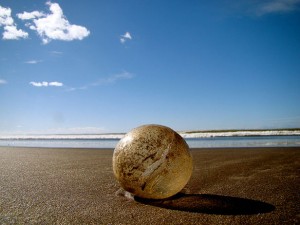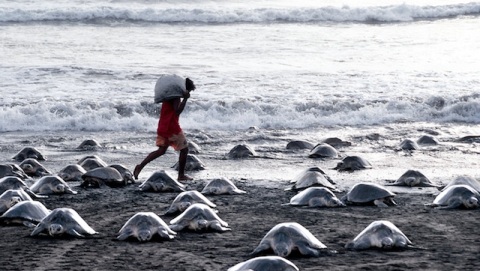Costa Rica News – While we’re approaching a chilly November in the U.S., Costa Rica is gearing up for its high season for tourism, which runs from late November to late April. Besides the country’s beautiful beaches, volcanic earth and lush flora and fauna, it attracts hundred of thousands of sea turtles to nest along its shores, including a critically endangered species, the Leatherback sea turtles.
 Costa Rica has a complicated past with these incredible, pre-historic creatures, whose eggs are fiercely sought after and sold within the country and on the black market. This has led to poaching of epidemic proportions, illegal trade and drug-related violence.
Costa Rica has a complicated past with these incredible, pre-historic creatures, whose eggs are fiercely sought after and sold within the country and on the black market. This has led to poaching of epidemic proportions, illegal trade and drug-related violence.
For decades, turtle meat and eggs have been considered a delicacy as well as an aphrodisiac; reportedly, turtle eggs are richer tasting than chicken eggs and are packed in protein. Turtle consumption has been a way of life in Costa Rica and other Latin American countries.
Today, you can still find turtle eggs in local bars, restaurants and markets that are off the beaten path, far from most tourist areas. And during the nesting season, roadside stands offer them by the bucket full for $2 per egg, which has also outraged Costa Ricans.
In 2010, the demand for black marketed turtle eggs inflated local sales by 500 percent. The demand for turtle eggs, which reportedly also comes from Asian markets, can cost from $100-$300 USD per egg. And with Costa Rica now becoming the new hub for drug trafficking, it is easy to see how the smugglers have added turtle eggs to their list. The market can be profitable as drug smuggling, but nowhere close to the high risk.
Conservation of this bio-diverse paradise and world-wide protection of the sea turtles weren’t a high priority until the mid ’70s. Yet, even today many feel the laws aren’t strict enough and conservationists are increasingly at risk to try and protect them and negotiate with poachers.
On May 30, while patrolling Moín Beach, near Limón on Costa Rica’s northern Caribbean coast, 26-year-old Jairo Mora Sandoval and four women (one from Spain and three from the U.S.) were kidnapped; Mora was beaten, tied up and dragged through the sand and left to suffocate on the beach he had vowed to protect. The women escaped, unharmed. Sandoval’s memory lives on through his friends, family and fellow conservationists, but his death is a tragic reminder of the constant struggle between conservation and crime.
“We’re not law enforcement,” said Vanessa Lizano, who heads the Costa Rican Wildlife Sanctuary and frequently walked the beach with Mora. “All we can do is negotiate. We used to have a very friendly relationship with some of the poachers and then they started to change. They got aggressive.”
According to the Sea Turtle Restoration Project, poaching on any Central American beach (and perhaps the world) is close to 100 percent if not protected. Studies have estimated various levels of poaching at different Costa Rica beaches, including 95 percent in the Guanacaste region, 98 percent in Esterillos, Costa Rica, and a 100 percent poaching rate in Punta Banco in 1995. In other countries, such as Honduras, where there is some record, indicates poaching at similar levels.
Two decades ago, a controversial plan was established by the conservationists at Costa Rica’s Ostional National Wildlife Refuge at Ostional Beach (on the Pacific side) where hundreds of thousands of Olive Ridley turtles arrive twice a year in what is called “arribadas” (arrivals.)
Over the course of the nesting season there can be millions of eggs strewn all over the beach, which are often trampled on and destroyed unintentionally by the turtles themselves. As a result, this diminishes the hatching success of the surviving eggs to just one-two percent.
To try and curb the problem and allow locals to continue making a living off these eggs without getting tempted to steal them, the conservationists came up with the idea of allowing them to take as many of the eggs as they wished, but only from the early nesting days. After that, the eggs are carefully protected.
While conservationists claim that the hatching rates in this area have gone up considerably, not every area is so lucky. There is still an ongoing threat in Costa Rica to protect both the sea turtles and conservationists.
By Melissa Castellanos, latinpost.com

